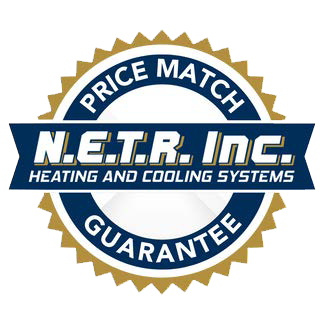The cost of a ductless heating and cooling system varies a lot based on the type of system you select. The most basic single-zone ductless systems with an outdoor condenser and an indoor air handling unit cost about $4,500. The price goes up from there — for instance, a multi-zone system with two indoor units typically costs between $8,500 and $12,000.
With such a wide range, how do you know what a ductless system costs? The best way to find the exact cost of installing ductless in your home is to contact us directly. We can send a comfort consultant to your home to talk about the options. In the meantime, take a look at the factors that influence the cost of ductless heating and cooling systems.

1. Number of Zones
The number of zones directly affects the cost of your ductless system. If you’re just installing a single-zone ductless unit in a sunroom or a basement, for example, you’ll only need to pay for a single indoor unit and a single outdoor condenser. In contrast, if you want whole home ductless, you will need to pay for multiple indoor units as well as the outdoor condenser.
Multi-zone condensers cost more than single-zone condensers. But you can connect up to eight indoor units on a single condenser, so it’s very, very rare for homeowners to need multiple condensers. You generally only need multiple outdoor condensers for large commercial buildings or multi-family dwellings.
Note that in addition to the extra equipment costs, multi-zone systems take longer to install. That drives up the installation costs as well.
2. Type of Outdoor Condenser
If you only want air conditioning, your condenser will probably cost a bit less than if you add heat. With heat, you can opt between the standard condenser and the hyper heat model. A hyper heat condenser runs efficiently even in very cold climates, but it costs more than a standard heating unit.
3. BTUs
Short for British Thermal Units, BTUs measure the cooling capacity or the amount of heat produced by your ductless unit. Specifically, a BTU is the amount of heat you need to increase the temperature of a pound of water by one degree. The higher the BTUs, the more your ductless system will cost.
As a general rule of thumb, you need about 12,000 BTUs for every 500 square feet of space, but you also have to consider the layout, building materials, insulation, and other heat load factors of the space you’re planning to heat and cool. A professional HVAC contractor can do a heat load calculation to ensure you select the optimal capacity for your home.
4. Efficiency
All ductless systems offer efficiency, but some systems are more efficient than others. Generally, you should expect to pay more for more efficient systems, but you will save money on operating costs in the long term.
5. Length of Pipe Runs
A variety of lines run between the indoor units and the outdoor condenser. These lines carry refrigerant, condensate, and electricity between the two units, and generally, they go through a line hide on the side of your home. The longer the lines and the hide, the higher the cost.
6. Labor Costs
When you buy a ductless system, you pay for the equipment plus the labor. Don’t choose the company that offers the cheapest labor — these installers often cut corners to keep their costs low. This can compromise the efficiency of your system or lead to issues down the road.
You should also avoid putting in your own system. Although self-installation can be tempting, it often ends up costing homeowners more. You need to buy accessories to connect the indoor and outdoor units, such as piping, line hide, whips, pads, stands, and disconnects. These supplies can add up, and generally, professional installers get cheaper rates because they buy in bulk. You may also need tools that you don’t have plus building permits.
Beyond the additional costs, you also need to consider the value provided by professional installers. They ensure that you select the right system for your needs, and they also help you pick the optimal placement to promote efficient operation.
7. Installation Challenges
The more labor required for the installation, the more you should expect to pay. For example, costs will stay relatively low if the installers can easily set up a condenser in the back of your house. However, installation costs will go up if the installer has to use a crane to put the condenser on your house.
8. Carpentry Considerations
A lot of ductless units are easy to install without doing any carpentry work. For example, installers can put up the majority of floor and wall-mounted ductless units without doing any carpentry work. These units mount to the studs in your walls, and the installer makes a very small hole in your wall to run refrigerant, drainage, and electrical lines to the outdoor condenser.
In contrast, if you opt for a recessed ceiling-mounted unit, the installer will have to cut through the sheetrock in the ceiling to make a spot for the unit. Rectangular ceiling-mounted designs slip between the ceiling joists or attic rafters, making installation fairly straightforward. But if you opt for a square-shaped, ceiling-mounted unit, a carpenter will need to cut through the joists or rafters and build supports for the unit. This can increase the cost of your ductless system.
9. Market Factors
Market factors such as supply chain issues also influence the cost of your ductless system. For example, between 2021 and 2022, the cost of plastic line hide tripled, copper for the metal ductwork and registers doubled, and foil tape went from about $5 or $6 a roll to $30. This increased the cost of ductless installation by about 20 to 25% over the previous year.
To reduce the impact of supply chain issues, look for a company that does a relatively large volume of business. They tend to have better connections and the ability to stock up on inventory. This helps to reduce unnecessary cost fluctuations.
10. Potential Savings From Switching to Ductless
When thinking about the cost of ductless, you also need to consider how much you’re going to save compared to your current heating system. This varies based on the type of system you use and the current cost of its energy source. MassSave offers an online calculator to help you compare the cost of your current heating system to upgrading to a ductless system.
Once you determine how much you’re likely to save, you can project your total savings over the lifetime of the unit. To give you an example, imagine that you’re going to save $300 a month compared to your current HVAC system. This equates to $3,600 a year or $36,000 over the next decade. However, you’ll save even more than that because ductless systems typically last 20 years or more. Take these numbers into account when deciding if it’s worth investing in ductless or not.
Keep in mind, however, that you also need to think about enhanced comfort. For instance, if you currently don’t have any AC but you’re planning to install a ductless unit with both heating and cooling, you’ll probably end up spending a bit more on electricity during the summer than you do now. However, in exchange, you’ll be more comfortable.
11. Financing for Ductless
The financing you use to pay for your ductless system also influences its total cost. If you get a 0% interest rate, you will only pay for the cost of the system. You can often find this if you’re able to pay off the balance within 24 months.
In contrast, if you use a loan that charges interest, you will end up paying slightly more for the system over time. However, this can be worth it if you want to spread out the cost over time.
12. Ductless Rebates
You can also offset the cost by applying for rebates. There are a variety of rebates designed to promote efficiency, but the options are constantly changing. When you work with NETR, Inc, we ensure that you get all of the rebates you’re entitled to, and we complete the paperwork on your behalf.
Get a Quote on a Ductless Heating and Cooling System
As explained above, there are numerous factors that affect the cost of a ductless heating and cooling system, and the cost varies for almost every homeowner. Want to know what it’s going to cost to put a ductless system in your home? Then, contact us today.
When you contact us at NETR, Inc, we will talk with you about your heating and cooling needs. We’ll send a comfort consultant to your home to assess the best type of system and to look for any installation challenges or considerations. Then, we’ll create a customized quote and help you learn more about financing and rebates to help you save on ductless.
